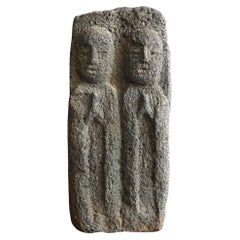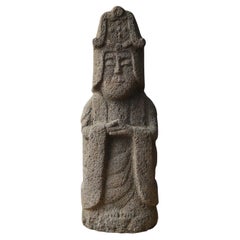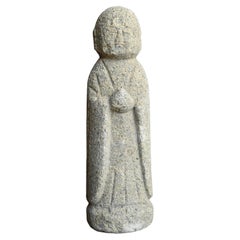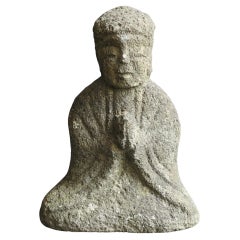Want more images or videos?
Request additional images or videos from the seller
1 of 13
Japanese antique two-piece stone statue of a monk / Do-so-jin / Edo period
$600List Price
About the Item
- Dimensions:Height: 8.86 in (22.5 cm)Width: 4.45 in (11.3 cm)Depth: 2.96 in (7.5 cm)
- Style:Edo (Of the Period)
- Materials and Techniques:
- Place of Origin:
- Period:
- Date of Manufacture:1600-1800
- Condition:Repaired: It is prone to falling over, so a rubber sheet has been attached to one part of it. This makes it stable.
- Seller Location:Sammu-shi, JP
- Reference Number:1stDibs: LU5487245033802
About the Seller
5.0
Platinum Seller
Premium sellers with a 4.7+ rating and 24-hour response times
Established in 2015
1stDibs seller since 2020
1,632 sales on 1stDibs
Typical response time: 5 hours
Authenticity Guarantee
In the unlikely event there’s an issue with an item’s authenticity, contact us within 1 year for a full refund. DetailsMoney-Back Guarantee
If your item is not as described, is damaged in transit, or does not arrive, contact us within 7 days for a full refund. Details24-Hour Cancellation
You have a 24-hour grace period in which to reconsider your purchase, with no questions asked.Vetted Professional Sellers
Our world-class sellers must adhere to strict standards for service and quality, maintaining the integrity of our listings.Price-Match Guarantee
If you find that a seller listed the same item for a lower price elsewhere, we’ll match it.Trusted Global Delivery
Our best-in-class carrier network provides specialized shipping options worldwide, including custom delivery.You May Also Like
Japanese Wood Carved Polychrome Sculpture of a Seated Temple Monk, Edo Period
Located in Studio City, CA
This is truly a wonderful piece with clear age and a nice patina to it. Very unique. We have not seen another quite like it. The monk appears to have glass eyes which gives his expression a very humanistic feel. The head is removable (please see the last image).
From a collection of Japanese arts and artifacts. Most likely dates back to the Edo period.
Would make for a nice addition to any Japanese or Asian artifacts...
Category
Antique 18th Century Japanese Edo Sculptures and Carvings
Materials
Wood, Lacquer
$3,250
H 18 in W 18 in D 13 in
Monk Head Bamboo and Glass Sculpture, Japan 19th Century, Edo Period
Located in PARIS, FR
Superb bamboo sculpture with glass eyes of a Japanese monk. Japan, 19th century, Edo period.
In good condition. Slight wear and small dent seen in photos.
Dimensions in cm (H x L x...
Category
Antique Early 19th Century Edo Busts
Materials
Bamboo, Glass
Japanese Antique Wooden Buddhist Figure, Edo Period '1603-1868'
Located in Hitachiomiya-shi, 08
This antique wooden Buddhist figure was crafted in the Edo Period (1603–1868).
Although the specific identity of the deity it represents is unknown, the figure has a gentle presence...
Category
Antique Mid-17th Century Japanese Edo Figurative Sculptures
Materials
Wood
Japanese Lacquered and Gilt Wood Buddhism Statue from Edo Period
Located in Atlanta, GA
An exceptional and wood statue of Buddhism Guardian Seitaka Doji from Japan circa Edo period (1603-1868), likely the earlier part of 17th century. One of two chief attendants of Fudou Myouou (the other being Kongara Doji), the name of Seitaka Doji is a transliteration of Sanskrit "Cetaka", meaning servant, slave, and he is said to personify expedient action. He is most commonly found on the right side of Fudou, together with Kongara Doji on the left, forming the Immovable triad, Fudou Sanzon, the terror of evil doers. Seitaka largely adheres to the iconography of a wrathful youth with fleshy body and face, skin in the color of a red lotus, has his hair tied in five knots, and holds a vajra in his left hand and a vajra-club in his right hand, but the actual artistic representations of him in Japan do...
Category
Antique 17th Century Japanese Japonisme Sculptures and Carvings
Materials
Metal
Japanese Edo Period Bronze Vase of Mimikuchi Flying Handle Form
Located in Buffalo, NY
A rare Edo period bronze vase with Mimikuchi flying handles, with quartered pear shaped body with spiral to the front and back, supported on a flared...
Category
Antique 1860s Japanese Edo Vases
Materials
Bronze
A Pair of Japanese Edo Period Stone Female Buddha Sattva Sculptures, c. 1750
Located in New York, NY
A Pair of Japanese Mid Edo Period Carved Stone Sculptures of Female Buddha Sattva, ca. 1750
PERIOD
Mid Edo Period (1603-1868)
DIMENSIONS
Height: 10.5 ...
Category
Antique 1750s Japanese Japonisme Figurative Sculptures
Materials
Stone
$4,500
H 10.5 in W 6 in D 4.5 in
Pair of Japanese Edo Period Musha Ningyo Courtier Dolls
Located in Austin, TX
Two exquisite Japanese musha ningyo dolls, crafted as courtiers, Edo Period, early 19th century, Japan.
The older man can be identified as the h...
Category
Antique Early 19th Century Japanese Edo Sculptures and Carvings
Materials
Shell, Brocade, Silk, Glass, Wood, Paint, Paper
Edo Period Japanese Bodhisattva Shrine
Located in Chicago, IL
An incredible Edo Period Japanese gilt and lacquered carved wood shrine depicting a Bodhisattva with piercing glass eyes, a contemplative expression, and h...
Category
Antique Early 1800s Japanese Japonisme Sculptures and Carvings
Materials
Giltwood, Lacquer, Wood
Antique Japanese Bamboo Kayakuire-Powder Flask , Edo Period.
Located in Leuven , BE
This artifact is an antique Kayakuire (火薬入れ), or gunpowder flask, a fascinating example of traditional Japanese craftsmanship. In feudal Japan, gunpowd...
Category
Antique 19th Century Japanese Natural Specimens
Materials
Bamboo, Wood
Japanese Carved and Lacquered Wood Shogun, Edo Period, 19th Century, Japan
Located in Austin, TX
An unusual Japanese carved wood, lacquer, and gilt decorated portrait sculpture of a shogun, Edo Period, early 19th century, Japan.
The unidentified shogun (possibly Tokugawa Iey...
Category
Antique Mid-19th Century Japanese Edo Sculptures and Carvings
Materials
Wood, Lacquer
$2,800
H 10.25 in W 10.5 in D 7.5 in
More From This Seller
View AllJapanese antique two-piece stone statue of a monk/God of the road/Edo period
Located in Sammu-shi, Chiba
We have a rare stone Buddha in stock.
This is a small twin-figure stone carving made in the early to middle Edo period (1600–1800). It features two standing monk-like deities side b...
Category
Antique 18th Century Japanese Edo Figurative Sculptures
Materials
Stone
Japanese antique Kannon stone statue/Edo period/Buddhist ornament
Located in Sammu-shi, Chiba
This is a stone statue of Kannon Bosatsu (the Bodhisattva of Compassion), believed to have been made in Japan during the mid to late Edo period (late 18th century onward). The materi...
Category
Antique Early 19th Century Japanese Edo Figurative Sculptures
Materials
Stone
Japanese Antique Edo Period Stone Buddha / 19th Century / Garden Ornament
Located in Sammu-shi, Chiba
This is a small Jizo Bodhisattva statue believed to have been made in the late Edo period (19th century). It is believed to be made of granite.
Its rough texture exudes a gentle aura...
Category
Antique 19th Century Japanese Edo Figurative Sculptures
Materials
Stone
Japanese antique small stone Buddha statue / Seated Buddha / 19th century / Edo
Located in Sammu-shi, Chiba
This is a small stone Buddha statue, a "seated Tathagata," created around the 19th century, during the late Edo period in Japan. Stone Buddha statues are scattered throughout Japan, ...
Category
Antique 19th Century Japanese Edo Figurative Sculptures
Materials
Stone
Edo Period Stone Buddha/1600’s/Japanese Antique Buddha Statue/Garden Ornament
Located in Sammu-shi, Chiba
This stone Buddha sculpture, believed to date back to the early Edo period or earlier, depicts Jizo Bosatsu in a seated pose.
Crafted from granite, it showcases the natural effects ...
Category
Antique Early 17th Century Japanese Edo Sculptures and Carvings
Materials
Stone
Small Edo period stone Buddha from Japan/Jizo Bodhisattva/1800s/Amulet
Located in Sammu-shi, Chiba
This is a small stone statue believed to have been made in Japan during the Edo period. It was placed at crossroads, village entrances, or along mountain paths to pray for the safety...
Category
Antique 19th Century Japanese Edo Figurative Sculptures
Materials
Stone



